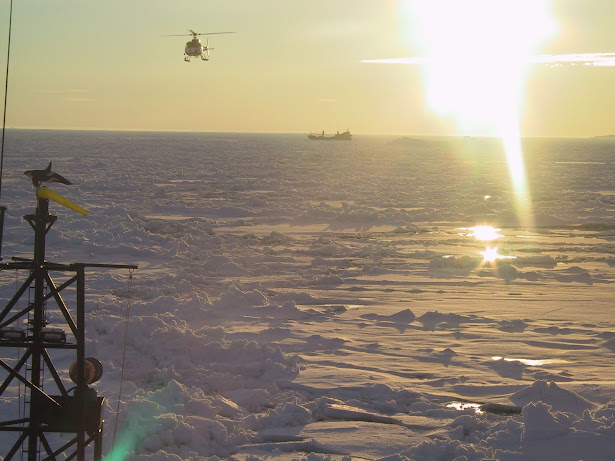You may be pleased to read that we are getting close to the end of this nostalgic ramble.
If you have stayed with me this far, I congratulate you and thank you for your endurance. If you are reading this for the first time, and want to catch up - HERE's the place to start.
Prydz Bay (68.17 deg S, 75.43 deg E)
Yesterday morning there was a yellow sticky note on the Bridge door. It said:
WE’RE NOT STUCK
JUST WAITING…
The little sign says it all. After several hours of bashing ice and getting nowhere while at all time worrying about the northerly wind closing the ice behind us and closing our line of escape, we have retired to a safe distance.
If we want to move now, we probably can, but with that same northerly blowing the ice back in on us, it would be hard work and an excessive use of fuel. So the strategy is – wait.
The break while everyone waits for the change in the weather is a good opportunity for an exhausted crew and voyage party to rest and recover from the sleeplessness of the past few days and get ready for the next ones which are likely to be every bit as challenging.
It's now late Sunday afternoon and the wind has come around just enough for Tony to give it another go. There have been one or two bar room experts who have decided that we really are stuck and not “waiting” despite our voyage leader's assuring address to everyone at a Mess Deck briefing earlier in the day.
The experts are nowhere in sight as we start in the early evening to move in closer towards Polar Bear who is where she has been for the past 24 hours or so, about three or four miles away.
Our escape route is looking secure, and the weather favourable as we start to work our way down a lead toward Polar Bear's stern. It takes about four hours to make the few miles through the ice and by 0100 we are within three ship lengths of her.
The last 300 metres takes eight hours to get us to a point where both ships are almost touching. Breaking ice for a rescue mission is not the same as breaking ice to make progress. We need to provide room for both vessels to manoeuvre and Tony’s aim is to smash enough of the thick unfriendly floes to allow progress by a conventional ship. So we crunch our way for a few ship lengths towards the stern, then do the same thing amidships and then to the bow, turning the ice into manageable lumps. We cannot charge in towards her using full power, otherwise a sudden breakthrough and we would become a battering ram rather than a rescuer - not a happy outcome.
It would be overstating it to suggest that the precision had to be surgical, but it certainly had to be precise. The skills and teamwork of Tony and his chief mate Scott, and the other team members continued to impress us all and at no time was there ever a suggestion that failure was an option.
By mid-afternoon, 24 hours since we first started to move in on Polar Bird, we have mooring ropes attached to her bow, and we begin trying to pull her around and into our track. This is laboriously slow, but after a few hours, we have her in tow and we are making slow progress towards the open sea, 30 or so miles to our north.
Just when things are starting to look good, the rope separates, and Polar Bird came to an abrupt stop. The ice is particularly unfriendly during this time, and Bird is having great difficulty making any progress at all through our wake.
We need a stronger towing line, and options are being considered including using one of Polar Bird’s anchor chains.
We back up as close as we can to Polar Bird’s bow, trying to chop up some of the gnarly bits with our propeller wash.
 Slowly, ever so slowly she starts making progress again and we push on.
The chopper is back in the air, with firstly, skipper Tony Hansen, then voyage leader, Greg Hodge and then Tony again aloft, directing traffic through the elusive little channels and ponds which appear and vanish and appear again somewhere else.
Slowly, ever so slowly she starts making progress again and we push on.
The chopper is back in the air, with firstly, skipper Tony Hansen, then voyage leader, Greg Hodge and then Tony again aloft, directing traffic through the elusive little channels and ponds which appear and vanish and appear again somewhere else. It is a long, long night with several stops as Polar Bird loses momentum and falls further behind, then catches up as we reverse and start the prop wash exercise again. Persistence and the combined skills of officers, crew, pilots and the voyage leader and his team eventually pay off. At 0400 the watery bits are getting more frequent and the thick rafted floes start to change to lighter ice which breaks easily under Aurora’s bow.
By 0430 we are in open water. Amid cheers and handshakes, the tension is released and thoughts of home on both ships became a reality.
The beer will taste good later tonight.

No comments:
Post a Comment